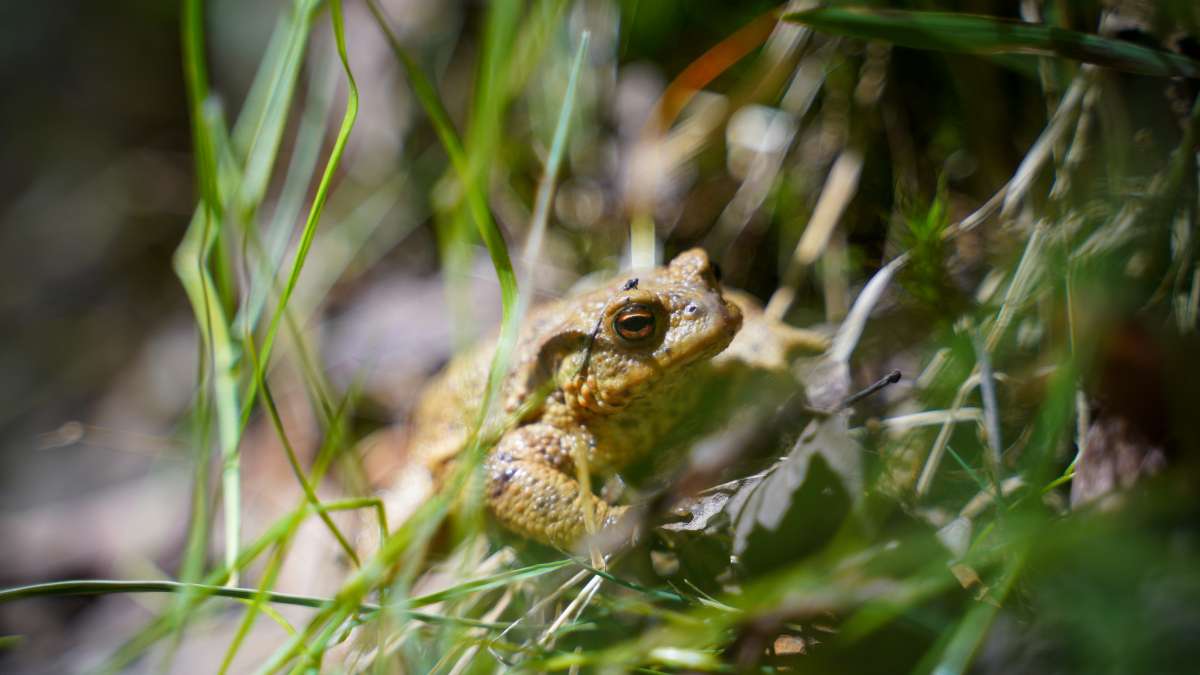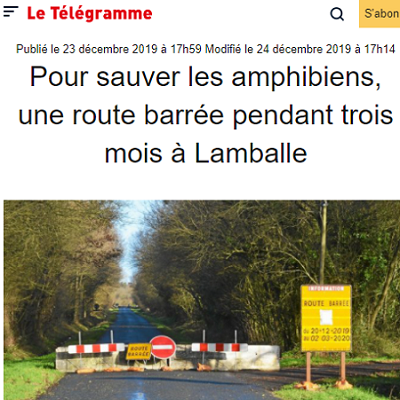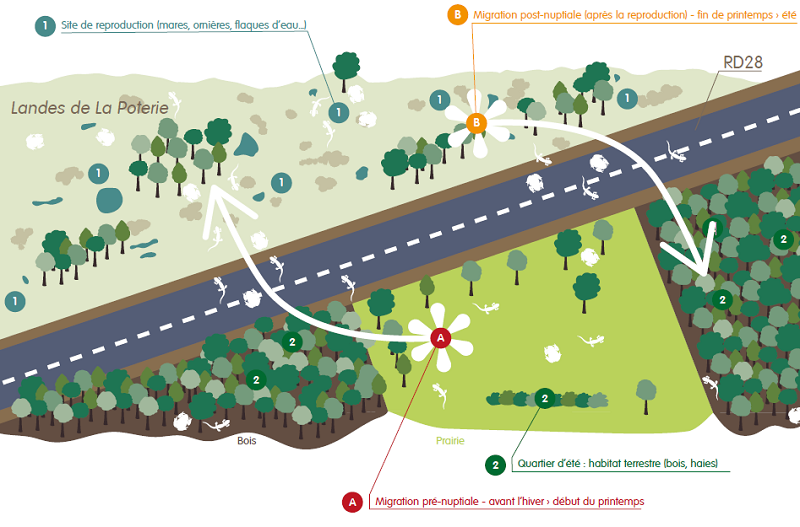This article is part of the folder : Mieux connaître les amphibiens pour mieux les protéger
See the 2 news related to this folder
Since mid-December and until mid-March, the RD28 departmental road has been closed in order to protect amphibian species which are currently migrating to their breeding habitats located on the other side of the road. During this period, a participatory process involving communities, environmental protection associations and residents was launched in order to choose the best solution to preserve biodiversity without harming this region's local populations.
An exceptional biodiversity
Located in the Côtes d'Armor department, in the municipality of Lamballe-Armor, the Landes de La Poterie site is Natura 2000 classified. It is home to exceptional flora and fauna. The latter includes eleven species of amphibians, all protected and often threatened. Toads, frogs, newts and salamanders thrive on this particularly attractive site due to the diversity of its natural spaces. Indeed, amphibians take up their summer quarters in the woods and meadows, whereas in winter, they travel to ponds, ruts and puddles to reproduce.
These different spaces, however, are located on either side of the RD28 road that these small animals are forced to cross twice a year. A deadly journey against which elected officials, associations such as Vivarmor Nature and some residents have decided to react.
Time for experimentation

For 3 winters, from 2016 to 2019, the Lamballe Terre & Mer agglomeration community, the VivArmor Nature association and many volunteers joined forces to install a crapaudrome. Under its appearance of a superstructure for amphibians, this term in fact designates a system for the manual movement of individuals.
Using buckets and 800 m of canvas, for 355 days spread over the 3 years, 60 volunteers helped newts, frogs, toads and salamanders across the road to their mating grounds, thus preventing them from being crushed by the 400 vehicles passing along the RD28 each day. Very restrictive in terms of man-time, this system was however effective since it helped save more than 4000 individuals.
After three seasons, a temporary solution while waiting to find the most suitable system was therefore initiated in 2019: the outright closure of the section of the road from 20 December 2019 to 2 March 2020 and the establishment of a detour, lengthening daily journeys. Thanks to this emergency solution, no amphibians were crushed during the winter of 2019-2020.
The experiment was to be limited to one year, but the health crisis linked to the Covid-19 epidemic and the lock-down it entailed did not allow its assessment and the establishment of an alternative and sustainable system for the winter of 2020-2021. The closure was therefore renewed on 14 December and the road will remain closed to vehicles until March 15.
The strength of partnership
Last July, a partnership agreement was signed between the Lamballe-Armor municipality, the Laballe Terre & Mer agglomeration community, the Côtes d'Armor departmental council and Cerema.
This agreement confirms the research and development mission entrusted to Cerema, whose objective is to find an effective, sustainable and collectively approved solution in order to preserve biodiversity without putting too much strain on public finances or hampering local residents.
Benefiting from the experience acquired at this site by Lamballe Terre & Mer and the VivArmor Nature association, the research and development mission entrusted to Cerema is multidisciplinary because it aims to establish a diagnosis that is not only ecological but also economic and sociological, in order to propose a shared solution.
Stages in the participatory process
On 20 October 2020, a public meeting was held with the inhabitants and users of Lamballe-Armor and more specifically those of La Poterie and Trégomar. A survey of residents is under way to identify their practices, their perceptions of the site and to collect their proposals. Participatory workshops and educational outings will also be organised in early 2021 at La Poterie.
To participate, residents can contact Lamballe Terre & Mer on +33(0)2 96 50 59 37 or at environnement@lamballe-terre-mer.bzh. Exchange meetings are also planned to analyse all the parameters to be taken into account in order to choose the best solution.
Several scenarios will be examined and compared. The effects of the winter closure tested for two years will be compared in all their aspects (ecological, economic and social…) with other solutions such as the installation of automatic barriers at certain periods and times (amphibians move mainly at night), the installation of a dedicated passage or the definitive closure of the road.

Finding the winning solution for everyone
The first step of the process will consist in extending the study of the prenuptial migration of the species which reproduce on the site without being limited only to the surroundings of the closed section of the RD28 road. As yet unidentified points of collision may indeed exist and the three years of manual transfer of amphibians have not allowed all the points of passage for animals in the Landes de La Poterie sector to be determined.
The various stages of the analysis and consultation will compare the different solutions according to multiple aspects. They will analyse the technical constraints, costs, production schedule, but also the necessary administrative procedures. They will also take into account the consequences of the different scenarios on safety and road traffic.
The consultation of residents and users, along with traffic counts, will also serve to determine how the closure of the road during the last two winters was perceived and used by the inhabitants, and if it generated new uses, for example of the closed road or alternative routes put in place.
The role of Cerema
Cerema has multidisciplinary expertise, not only on aspects related to biodiversity, but also in terms of development, traffic analysis and consideration of economic and social aspects.
Cerema Ouest, pilot of the project, will rely on the developments recently implemented by other communities on other sites such as La Flèche (72) or Moisdon-la-Rivière (44), but also on experts of these questions within the Cerema network which, moreover, published in 2019 a study specifically dedicated to systems for crossing land transport infrastructures by amphibians.
The participatory approach, including a technical and educational dimension, is experimental and is of particular interest to Cerema wishing to work more closely with communities and civil society. In addition to the preservation of amphibians and their habitats, it will serve to raise popular awareness of the stakes of biodiversity in their region, in the broad sense, but also to question uses and their impact on ecosystems of the Landes de la Poterie site.
A guide (in French) has also been published on the systems allowing amphibians to cross roads and transport infrastructures. It is available for download from the Cerema online store.
Educational and awareness raising tools
As part of this project, educational and awareness-raising tools were designed and distributed to the population.
An amphibian identification booklet and a fact sheet presenting their migration, in order to take part in the population surveys, were prepared, enabling inhabitants to better identify amphibian traffic sites.
In the press
In the folder : Mieux connaître les amphibiens pour mieux les protéger

